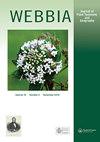Applications of leaf architecture characters in delineating selected species and infraspecific taxa of Genus Cucumis L. (Cucurbitaceae)
Q3 Agricultural and Biological Sciences
引用次数: 0
Abstract
Leaf venation characters of twelve (12) Cucumis taxa, comprised of eight species, three subspecies, and three varieties were examined to determine patterns of leaf architectural characters and delineate these accessions at the species, subspecies, and variety level. The leaf architecture of twenty-seven accessions representing six taxa were examined and described in this study. Additionally, data on the leaf architecture of another six taxa (represented by 57 accessions) published by Masungsong et al. (2022) were incorporated in the analysis. Results revealed that the twelve (12) taxa of Cucumis primarily varied in blade class, apex angle, primary vein size, secondary vein spacing, tertiary vein angle to primary vein, and areole development. These variations were found consistent with Cucumis species examined in previous studies. A dichotomous key was constructed for the twelve Cucumis taxa using leaf characters derived. Cluster analysis (based on UPGMA) formed two major clusters at 0.130 Gower distance. Cluster I includes Cucumis melo subsp. melo, C. pustulatus, C. melo var. flexuosus, C. melo subsp. agrestis, and C, melo var. texanus which exhibited secondary vein spacing that increases towards the base. while Cluster II is composed of the remaining Cucumis taxa, all displaying irregular secondary vein spacing. Furthermore, sub-clusters were formed based on tertiary vein angle in relation to primary vein, blade class, apex angle, and primary vein size. Results showed that utilizing leaf architecture is an effective technique to describe, characterize and delineate closely related taxa with many similar characters.叶片结构特征在黄瓜属(葫芦科)选定种和种下分类群划分中的应用
摘要对黄瓜12个类群(8种、3亚种、3变种)的叶脉特征进行了研究,并在种、亚种和品种水平上对其叶片结构特征进行了描述。本文对代表6个分类群的27份材料的叶构型进行了研究和描述。此外,Masungsong et al.(2022)发表的另外6个分类群(57份)的叶结构数据也被纳入分析。结果表明,黄瓜12个类群在叶片类别、先端角、初级静脉大小、次级静脉间距、第三静脉与初级静脉的夹角以及环孔发育等方面存在显著差异。这些变异与以往研究的黄瓜品种一致。利用得到的叶片特征,构建了12个黄瓜类群的二分类键。聚类分析(基于UPGMA)在0.130高尔距离处形成两个主要聚类。集群I包括甜瓜亚种。甜瓜,甜瓜,甜瓜变种,甜瓜亚种。C, melo var. texanus,其次脉间距向基部增加。聚类II由剩余的黄瓜类群组成,所有类群的次脉间距都不规则。此外,根据与主脉相关的第三脉角、叶片类型、先端角和主脉大小,形成了子簇。结果表明,利用叶构型是描述、表征和圈定具有许多相似特征的密切相关分类群的有效方法。
本文章由计算机程序翻译,如有差异,请以英文原文为准。
求助全文
约1分钟内获得全文
求助全文

 求助内容:
求助内容: 应助结果提醒方式:
应助结果提醒方式:


